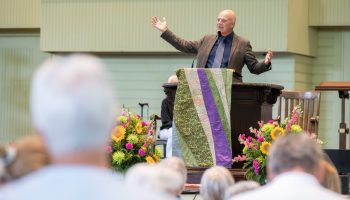
Ilana Kaufman, CEO of the Jews of Color Initiative, speaks Monday in the Hall of Philosophy.
There are more than 1 million Jewish people of color in the United States. As CEO of the Jews of Color Initiative, Ilana Kaufman’s job is to lead the nonprofit in its mission of building “a truly multiracial, antiracist Jewish community in which Jews of color can reach our full potential and belong as leaders and members of the Jewish community.”
They do this work through grant-making, creating structural and communal support for Jews of color, supporting leaders and their ideas, and conducting research. But perhaps most importantly, the organization works to expand knowledge about the community it is named for.
“We are living in a nation that is pulled at the seams by identity-based conflicts born from, and integral to, the infrastructure of this country — including and sometimes in partnership with our faith communities,” Kaufman said Monday in the Hall of Philosophy, opening the Interfaith Lecture Series Week One theme of “Race and the American Religious Experience.” “I believe that we want each other to succeed, to be whole, to fully thrive embodied at the intersection of our diverse identities. And to thrive as neighbors, friends and colleagues as a United States community, we must dissolve, retire, evolve from the binary race-based identity thinking and acting that further distances, rather than connects, us to one another.”
At the intersection of black-and-white thinking about who compromises the Jewish community in America, she said, are Jewish people of color — people who aren’t always counted. In 2018, the most pressing topic that JoCI could address in the face of omission or lack of representation of Jews of color, Kaufman said, was to formally research the question: “How many Jews of color are there, anyway?”
Jewish censuses date back to Biblical times and the Book of Numbers; in America, the Jewish community has been conducting censuses since the 1800s. But in the “same spirit of the census which excluded the counting of women, never once did any of the organized efforts to count Jewish people in the United States include the counting of nonwhite Jews,” Kaufman said.
A meta-analysis of the U.S. Jewish community followed, with a Stanford team mining Jewish demographic students for as much information on racial diversity in the community as they could find.
They found that, at minimum, 12 to 15% of the 7 million Jews in America are people of color, Kaufman said. Twenty percent of Jewish families identify as multiracial; on the coasts, it’s 25%.
“From counting inconsistencies, in addition to the demographic numbers, we also learned that from racism which usually resulted from, and was expressed by poor pedagogy, resulted in Jews of color in the United States being chronically discounted or undercounted, which resulted in the complete omission of Jews of color from Jewish demographic studies and by extension, organized Jewish life.”
Another study followed in 2020, commissioned by JoCI. Data collected from more than 1,100 respondents, from 47 states and Puerto Rico, reflected an important picture, Kaufman said — one of existing inside the Jewish community, and outside of it.
“We learned that Jews of color understand the unique, brand-identity consciousness and racism in the United States, experiencing racism as people of color through the general society,” she said, “and as Jews of color moving through our own Jewish community. We maintain constant awareness about how we are seen by others, knowing that we can be scrutinized because of our race in some settings and because of our Jewish religion and other settings.”
This double-consciousness is incredibly stressful, she said, and the data backs up that burden. Eighty percent of Jews of color have experienced discrimination inside Jewish settings. More than half experience racial discrimination in spaces like congregations and synagogues — spaces where everyone should be having “unencumbered access to God.” Sixty-six percent of surveyed Jews of color said their leaders were either poorly, or very poorly, addressing the need for creating racial ethnic diversity inside Jewish organizational leadership.
“But,” Kaufman said, “it is not all dismal. There is also some moderately fair news. We learned that even with real challenges comes the opportunity for a sense of connectedness and purpose.”
For example, 51% agreed they had a sense of belonging among white Jews, and 41% agreed they’ve been able to “find opportunities to express all sides of ourselves in predominantly white Jewish settings.”
“It is in this diversity of experiences had by Jews of color, punctuated by the ability to simultaneously hold the challenging and the positive that, beyond the count, offers us insight into how not only Jews of color, but people of color — and all Americans committed to a thriving multiracial future — can more meaningfully and purposely connect, build and reinforce community, navigate through racism, and collectively thrive.”
The United States is on track demographically to become majority-PoC in 2044; the U.S. Jewish community becomes more racially diverse every day, too, Kaufman said. Strengthening both racial and religious identity — rather than holding those identities in competition with each other — results in not just a stronger racial and religious community, but a stronger U.S. Jewish community as a whole, Kaufman said. That, she posited, makes for a stronger civic community.
Kaufman concluded with the same remarks she shared at the outset: that the nation is pulled at the seams by race- and identity-based conflicts. But, “we are also neighbors, friends, colleagues and in multiracial community together.”
“We must want each other to succeed, to be whole, to thrive fully embodied, not only at the intersection of being Jewish and people of color, but at the intersection of religious faith, racial diversity, and the incredible promise held inside all of us as members of the extraordinary multiracial Jewish and United States community.”




